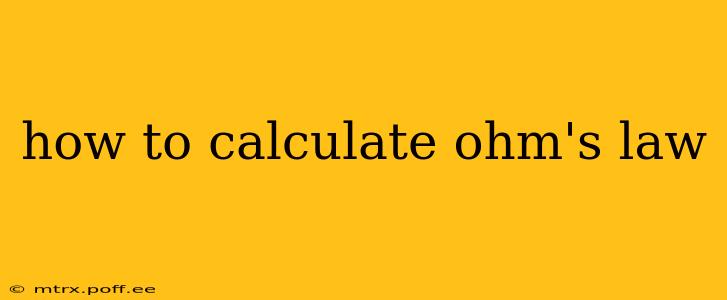How to Calculate Ohm's Law: A Comprehensive Guide
Ohm's Law is a fundamental principle in electronics, describing the relationship between voltage (V), current (I), and resistance (R) in an electrical circuit. Understanding how to calculate using Ohm's Law is crucial for anyone working with electronics, from hobbyists to professional engineers. This guide will walk you through the basics and provide examples to solidify your understanding.
Ohm's Law states: V = I * R
Where:
- V represents voltage, measured in volts (V). Voltage is the electrical potential difference between two points in a circuit. Think of it as the "pressure" pushing electrons through the circuit.
- I represents current, measured in amperes (A) or amps. Current is the rate of flow of electric charge. It's the actual movement of electrons.
- R represents resistance, measured in ohms (Ω). Resistance is the opposition to the flow of current. Think of it as friction in the circuit.
Understanding the Three Forms of Ohm's Law
The basic formula, V = I * R, can be rearranged to solve for any of the three variables:
- V = I * R: Used to calculate voltage when current and resistance are known.
- I = V / R: Used to calculate current when voltage and resistance are known.
- R = V / I: Used to calculate resistance when voltage and current are known.
Examples of Ohm's Law Calculations
Let's illustrate with some practical examples:
Example 1: Calculating Voltage
A circuit has a current of 2 amps (I = 2A) and a resistance of 10 ohms (R = 10Ω). What is the voltage (V)?
Using the formula V = I * R:
V = 2A * 10Ω = 20V
Therefore, the voltage in the circuit is 20 volts.
Example 2: Calculating Current
A circuit has a voltage of 12 volts (V = 12V) and a resistance of 4 ohms (R = 4Ω). What is the current (I)?
Using the formula I = V / R:
I = 12V / 4Ω = 3A
Therefore, the current in the circuit is 3 amps.
Example 3: Calculating Resistance
A circuit has a voltage of 9 volts (V = 9V) and a current of 1.5 amps (I = 1.5A). What is the resistance (R)?
Using the formula R = V / I:
R = 9V / 1.5A = 6Ω
Therefore, the resistance in the circuit is 6 ohms.
Frequently Asked Questions (FAQ)
What are the units used in Ohm's Law?
Ohm's Law uses volts (V) for voltage, amperes (A) for current, and ohms (Ω) for resistance. It's crucial to use consistent units for accurate calculations.
What happens if I use incorrect units?
Using inconsistent units will lead to incorrect results. Always ensure you are using volts, amperes, and ohms.
Can Ohm's Law be applied to all circuits?
Ohm's Law applies primarily to linear circuits, where the relationship between voltage and current is directly proportional. It doesn't accurately describe the behavior of all circuits, particularly non-linear components like diodes and transistors.
How can I remember the Ohm's Law formulas easily?
A helpful mnemonic is the "Ohm's Law Triangle":
V
---
I R
Cover the variable you want to calculate, and the remaining variables show you the calculation. For example, covering 'V' leaves 'I' x 'R', indicating V = I * R.
How accurate are Ohm's Law calculations in real-world scenarios?
While Ohm's Law provides a good approximation, real-world circuits often involve factors that can slightly affect the results. Temperature changes, component tolerances, and other factors can introduce small variations.
By understanding the basic formula and its variations, along with the units involved, you can confidently apply Ohm's Law to various electrical circuit calculations. Remember to always double-check your work and use consistent units to ensure accurate results.
